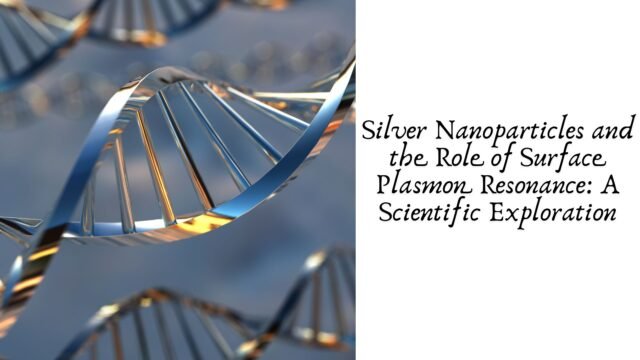Introduction
Silver nanoparticles (AgNPs) have emerged as one of the most fascinating materials in nanoscience due to their unique optical, electrical, and chemical properties. Among these, one of the most significant phenomena associated with silver nanoparticles is surface plasmon resonance (SPR). This optical feature is central to many applications in biosensing, imaging, photothermal therapy, and environmental monitoring. In this article, we will delve into what SPR is, how it arises in silver nanoparticles, and the transformative role it plays across various fields of science and technology.
Understanding Surface Plasmon Resonance (SPR)
Surface plasmon resonance is a physical phenomenon occurring when conduction electrons on the surface of metallic nanoparticles oscillate collectively in resonance with incident light. For silver nanoparticles, which are typically 10–100 nanometers in size, these resonant oscillations occur at specific wavelengths of visible light, giving rise to strong absorption and scattering properties.
At the core of this effect is the interaction between electromagnetic waves and free electrons on the nanoparticle’s surface. When light hits the nanoparticle, it excites the surface electrons, causing them to oscillate. At a particular frequency—known as the SPR frequency—this oscillation reaches maximum amplitude, resulting in a peak in light absorption and scattering.
Why Silver Nanoparticles?
Among noble metals, silver exhibits the strongest SPR effect due to its high conductivity and low damping of electron oscillations. This makes it superior in many ways to other metals like gold or copper when it comes to plasmonic behavior. Silver nanoparticles exhibit intense SPR bands in the visible range, making them particularly useful for optical applications.
Key reasons for silver’s prominence in SPR studies include:
- High Efficiency: Silver exhibits minimal energy loss during electron oscillation.
- Tunable SPR: The SPR wavelength can be easily adjusted by changing particle size, shape, or surrounding medium.
- Sharp Spectral Peaks: Silver provides narrower SPR peaks, leading to higher sensitivity in detection methods.
Factors Influencing SPR in Silver Nanoparticles
Several parameters influence the SPR characteristics of silver nanoparticles:
- Size and Shape: Smaller nanoparticles (10–30 nm) typically show SPR around 400–420 nm, while larger particles or those with anisotropic shapes (rods, triangles) can show red-shifted and multiple SPR peaks.
- Dielectric Environment: The medium surrounding the nanoparticle affects the SPR frequency. A higher refractive index leads to a red shift in the SPR band.
- Aggregation State: When nanoparticles aggregate, their SPR bands broaden and shift, often leading to new plasmon coupling effects.
- Surface Coating or Functionalization: Chemical modifications of the nanoparticle surface can alter the local refractive index, affecting SPR properties.
Applications of SPR in Silver Nanoparticles
Because of their tunable and strong SPR response, silver nanoparticles are extensively used in the following areas:
Biosensing
SPR-based biosensors using silver nanoparticles are highly sensitive and capable of detecting molecular interactions in real time. When a biomolecule binds to the functionalized surface of a silver nanoparticle, the local refractive index changes, leading to a measurable shift in the SPR peak.
Applications include:
- Detection of DNA and RNA
- Monitoring of antigen-antibody interactions
- Pathogen detection in food and water
Medical Imaging and Diagnostics
Silver nanoparticles enhance contrast in imaging techniques such as surface-enhanced Raman spectroscopy (SERS) due to their strong plasmonic effects. This allows for detailed imaging of tissues and even single molecules.
Photothermal Therapy
Silver nanoparticles absorb light and convert it to heat efficiently at SPR wavelengths. This property is harnessed to selectively destroy cancer cells by heating them without damaging surrounding healthy tissues.
Environmental Monitoring
SPR-based sensors using silver nanoparticles can detect trace amounts of pollutants, heavy metals, and toxins in air and water by monitoring shifts in their optical spectra.
Colorimetric Sensing
Changes in the SPR band often result in visible color changes, allowing for the development of simple, naked-eye colorimetric sensors for detecting biological agents, chemicals, or changes in pH.
Recent Advancements in SPR Research with Silver Nanoparticles
Research continues to enhance the capabilities of SPR in silver nanoparticles:
- Hybrid Nanostructures: Combining silver with other materials like graphene or silica to improve stability and performance.
- Controlled Synthesis: Advanced synthesis techniques offer precise control over shape and size, enabling tailored SPR responses.
- Integration with Microfluidics: SPR-based detection systems are now being integrated with lab-on-a-chip platforms for portable diagnostics.
Challenges and Considerations
Despite their advantages, silver nanoparticles face some challenges:
- Stability: Silver is prone to oxidation, which can degrade its plasmonic properties.
- Toxicity: Concerns about cytotoxicity limit the in vivo use of silver nanoparticles unless thoroughly coated or encapsulated.
- Reproducibility: Achieving consistent synthesis with controlled SPR properties across batches can be difficult.
Conclusion
Surface plasmon resonance is a defining characteristic of silver nanoparticles and a cornerstone for their diverse applications in science and technology. Whether enabling ultra-sensitive biosensors or advancing cancer treatment, SPR elevates the functionality and utility of silver nanomaterials. As synthesis techniques become more sophisticated and safety issues are addressed, the role of SPR in silver nanoparticles will only grow stronger, offering a bright future for nano-enabled innovations.







